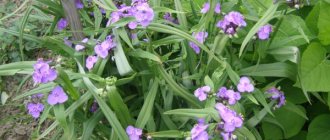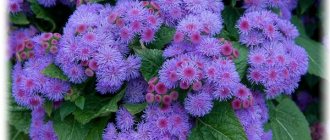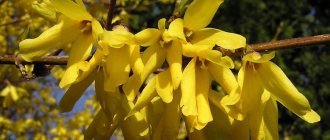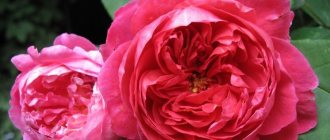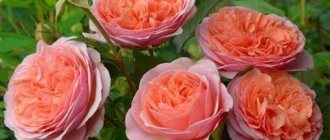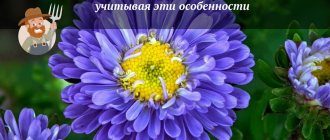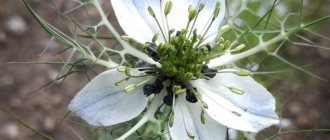Cloves - types and varieties
Carnations are distinguished by their rare diversity and number more than 250 species, subspecies and many varieties. The varieties used in floriculture are very decorative, quite unpretentious and are often grown as annual and biennial plants.
Some small-flowered, low-growing species - grass, sandy, needle-leaved, glaucous, some varieties of pinnate carnation overwinter well in the ground and are grown as perennials.
Turkish clove
The Turkish or bearded carnation is perhaps the most favorite type of this wonderful plant, grown in a two-year cycle. Bright, persistent flowers appear already in June, decorating flower beds, when the summer flowers have not yet entered into full force. The color palette of varieties and hybrids of Turkish carnations is extremely diverse - from fawn tones (pale pink, white, cream) to the most beautiful bright single-color and multi-color varieties.
Heimatland
Turkish carnation variety Heimatland
The spectacular variety is valued for its early and long flowering - the buds bloom already in May, the bushes remain decorative until the end of July. The plants are powerful, 50–55 cm high, the leaves and shoots are dark green with a characteristic burgundy tint. Inflorescences up to 12 cm in diameter are composed of flowers with serrated dark red petals and white eyes. Flowering is long, the plants are stable, and do not lose their decorative appearance in rainy weather.
Lahskenigin
Another early-flowering variety grows as a compact bush up to 45 cm high and 35–45 cm in diameter. Green shoots and leaves are decorated with large flowers with a diameter of 2.0–2.2 cm, collected in round inflorescences. The petals are dense, with a finely toothed edge, and a brilliant salmon-pink color. Flowering is abundant - from mid-May to the end of July.
Schneeball
A reliable ancient variety with exceptionally pure white petals. Medium-sized plants reach a height of 35–40 cm, forming rounded bushes up to 45 cm in diameter. Lush inflorescences, 10–11 cm in diameter, consist of large snow-white double flowers with a jagged edge. The variety blooms in June-July.
Chinese carnation
A perennial herbaceous plant native to China and grown as an annual crop. Of the numerous subspecies in home gardening, the most common is the Chinese carnation Heddeviga. The plants are small, with beautiful flowers of various colors, double and non-double, often with intricate patterns, with virtually no aroma.
Mary
Chinese carnation variety Mary
A cheerful variety with rounded bushes up to 25 cm high and rich green shoots hidden under flowers at the peak of decorativeness. The flowers are 4 cm in diameter, simple, with a feathery edge of the petals, bicolor - the carmine-red center stands out brightly against a delicate white-pink background. Blooms from early July until severe frosts. The variety is suitable for flower beds and potted plants.
Vesuvius
The popular variety is characterized by rounded bushes, 25–30 cm high, with elongated green leaves and a burgundy tint at the shoot nodes. The flowers are 6–7 cm in diameter, densely double, fiery red, very rich in color, with a jagged edge. Flowering from early July until severe frosts. This is one of the most beautiful red varieties of Heddevig's carnation.
Schwarzer Prinz
The dark-colored inflorescences of the Black Prince look stunningly impressive. The bushes are compact, 22–25 cm in diameter, with green leaves and shoots with a brownish tint at the nodes. The flowers are densely double, 5–6 cm in diameter, dark burgundy, almost black, with a bright white border along the jagged edge of the petals. Blooms from mid-June until autumn frosts.
Pests and diseases
Garden carnations are threatened by aphids and spider mites. They get rid of pests by spraying plants with Aktara, Iskra, and Mospilan.
Flowers can suffer from fungal diseases: rust, powdery mildew, gray rot. To get rid of the infection, the flowerbed is abundantly irrigated with Fitosporin, Alirin, Skor, and Bordeaux mixture.
Prevention measures:
- moderate watering at the root;
- frequent loosening of the soil;
- refusal to fertilize with slurry.
Possible problems
When growing cultivated varieties of cloves, you may encounter the following difficulties:
| Problem | Possible reasons |
| seeds take a long time to germinate | no stratification, deep planting |
| shoots stretch, weak | not enough light, high temperature in the greenhouse |
| seedlings die from blackleg | high substrate humidity, poor drainage, watering with cold water |
| flowering is scanty | little nutrition, insufficient watering |
Dutch carnation (garden)
Dutch carnation (garden)
Under the name garden or Dutch carnations, extensive breeding groups of perennial plants are united, the most common of which are Margaret, Grenadine and Chabot.
Carnations of the Margaret are characterized by remontant flowering, which lasts continuously throughout the season. Beautiful plants 40–50 cm high, dotted with fragrant flowers in white, yellow or red tones with delicate, deeply dissected petals.
Representatives of the group bloom well after transplantation; they are dug up in the fall, decorating greenhouses and winter gardens in late autumn and winter. Margaret's group does not stand well in the section, so it is not used for these purposes.
Grenadine group of carnation varieties is characterized by powerful bushes up to 60 cm high, with narrow bluish leaves, pleasantly smelling double or simple inflorescences of various colors. One of the advantages of this perennial carnation is the possibility of successful wintering in mild winters, for which the plants are covered with spruce branches or other available materials in the fall.
The most famous varieties are:
- Schneeflocke with snow-white flowers;
- Rosakenigin (Rosakenigin) with flowers of a deep pink tone;
- Morenkenigin (Morenkenigin) with dark, burgundy-red inflorescences.
And yet the most famous representative of garden carnations is the lush beauty Shabot . This group includes remarkably decorative varieties and hybrids in a huge selection diversity.
Care instructions
Sunny, warm places.
Calcareous, well-drained soil, not too wet in winter.
Wild carnation species are unpretentious to soil composition and care, but need well-lit areas. Basically, they are used for planting in rock gardens, rockeries and as part of natural flower beds.
Cultivated varieties and hybrids are more capricious. They require fertile and well-drained soil and regular feeding. They are often grown as houseplants.
Watering
Moderate.
All species, except Dutch carnation, are drought-resistant. The Dutch variety is watered 2 times a week. The water is not cold, it is poured under the root. Excess moisture in the soil leads to the spread of fungal diseases.
Top dressing
Natural perennial species are fertilized in the spring, scattering humus over the thawed soil in a layer of 2-3 cm. In the second half of summer, it is useful to add ash for loosening, 2 cups per 1 sq. m.
m. Starting from the budding period, Dutch carnations are fed every 2 weeks with complex fertilizer for flowering annuals.
After flowering, it is advisable to feed it a second time - with a solution of complete mineral fertilizer.
Transfer
The flower tolerates transplantation well.
Seedlings are planted in the phase of 2-4 true leaves, without deepening the root collar. Perennial carnations - ground covers are planted once. at 4-5 years, as the curtains grow, simply separating the required part from the general mass.
Wintering
Perennial low-growing carnations tolerate winter well, covered with snow.
If there is not enough snow, the bushes are mulched with sawdust, straw, and covered with agro-fabric.
Video recommendations for carnation formation
From the channel Garden, vegetable garden, with your own hands.
Carnation Shabo
Spectacular plants are distinguished by rather large bushes, the brittle shoots of which are covered with greenish-gray narrow leaves and decorated with fragrant large flowers, single or collected in inflorescences. To preserve varietal properties, vegetative propagation by cuttings is used, by digging in the uterine bushes in the basements in the winter. You can read more about growing Shabot carnations in the article “Shabot carnations.”
Champagne
Carnation Shabot variety Champagne
A very beautiful, joyful variety with double golden-yellow flowers 5–6 cm in diameter, emitting a delicate aroma. One bush produces about 20 flowers per season. Plants up to 50 cm high, with erect shoots suitable for cutting. Flowering is long - from June to October. In autumn, carnations are dug up, planted in flowerpots and decorated with cold verandas.
Mikado
The bushes are slender, up to 60 cm high, with graceful green shoots and narrow leaves, with a characteristic purple tint in the internodes. The flowers are large, very double, silky in texture, rich violet-lilac in tone with a finely toothed edge. Propagation by cuttings, flowering from late June to September-October. The variety looks great when cut.
Aurora
Carnation Shabo variety Aurora
Erect bushes with long shoots up to 65 cm high, green in color with a bluish bloom. The inflorescences are full, round, densely double, with gentle transitions of tones from salmon to light pink. The petals are dense, the edges are finely toothed. One of the best pink varieties is quite cold-resistant and will decorate flower beds until October. Plantings of this pink variety are very decorative and look luxurious next to the purple Mikado flowers.
Zhanna Dionysus
Large boiling-white flowers with delicate wide petals, the shape and fullness of the inflorescences are more similar to small peonies. The bush is medium in size, with strong shoots up to 50 cm high and narrow lanceolate leaves of dark green color. The flowers are lush, up to 8 cm in diameter, double or semi-double, great for cutting. This wonderful white variety is hardy and can withstand cold and dry periods.
feathery carnation
A low-growing species that grows in poor soils in the mountainous areas of northern Europe. Cushion-shaped bushes with long, needle-like leaves and pink or white flowers are essential in garden design. Hardy plants, which are accustomed to cold winters with little snow, overwinter well in open ground.
Double Rose
Feathery carnation variety Double Rose
Neat round bushes 25–30 cm in height and diameter, covered with dark green elongated leaves. Against this background, the shining pink color of double inflorescences looks bright and very attractive. The terry nature of the flowers is further enhanced by the feathery fringed edge. The variety blooms at the beginning of summer and blooms until the end of July. The frost-resistant plant overwinters well with light shelter.
Haytor White
Feathery carnation variety Haytor White
This exquisite variety forms dense clumps 20–30 cm high and up to 40 cm in diameter. In spring, the color of the shoots and elongated leaves is gray and eventually becomes green. In June, the bushes are covered with snow-white double flowers with a fine-toothed edge, similar to needles of frost. Flowering lasts until the end of July, but even later the compact green plants retain their decorative properties.
If you decide to grow this type of carnation, we advise you to read the article “Feathery carnation“.
Reproduction methods
The main, fastest and most effective way to propagate garden carnations is by seed. Most species, except first-generation hybrids, are easily renewed from self-collected seeds. If desired, perennial carnations can be propagated by cuttings, rooting layering or dividing the bush.
Cuttings are taken in early summer. Young shoots 10 cm long without peduncles are suitable for rooting. Cut obliquely under the leaf node, removing the lower leaves. A shallow incision is made along the outermost internode. Root in clean sand in greenhouse conditions. Roots appear in 3-4 weeks. By mid-August, the cuttings are ready to be transplanted to a permanent location. By autumn they manage to get strong enough to survive the winter.
Garden carnations are propagated by layering as follows:
- On one of the lower shoots, longitudinal cuts are made from one internode to another.
- Dig in the “damaged” parts of the shoots, fixing them in the ground.
- When lateral stems begin to grow from the outermost internode, the cuttings are ready for transplanting.
Only two types of garden carnations, Turkish and Dutch, are propagated by division. The procedure is carried out in the spring, before the bush puts on buds, or in the fall, after flowering. Carnations are dug out of the ground, trying not to damage the roots, and cut into several parts so that each has 3 growing points and developed roots. The cuttings are planted in a permanent place and cared for like seedlings.
Sand carnation
Unlike the previous species, the birthplace of the sand carnation is the Mediterranean countries. Herbaceous perennial plants form a dense turf with pink and white peduncles up to 30 cm high, prefer sandy loam, are unpretentious in care, frost-resistant and drought tolerant.
Nostalgia
Sand carnation variety Nostalgia
The compact bush is formed by short, densely leafy shoots of a bluish-green color. On slender peduncles up to 30 cm high there are simple-shaped white flowers with a cream center. The petals are strongly dissected, with a long thin fringe. The variety blooms very profusely, in June-July, and is characterized by a strong, pleasant aroma.
Sea foam
Dense bushes, growing in width year after year, do not grow more than 15 cm in height. The stems are branched, the leaves are clear green. White fragrant flowers are small, five-petal in shape, up to 2.5 cm in diameter. The edges of the petals are finely cut, fringed. Blooms for a long time, from mid-summer to early autumn. Used for rocky slides and border design.
Dianthus grass
Fans of alpine slides are well aware of this wonderful species, loved for its compactness and unique decorativeness. Plant height is no more than 15–20 cm, shoots are knotty, thin, creeping. Small, exquisitely shaped flowers are painted in colorful, pure shades.
Flowering is extremely generous and long - from mid-May to October with short breaks. Spectacular bushes are literally doused with bright flowers all season, invariably attracting the eye.
Confetti Deep Red
Plants with long shoots form spherical bushes up to 15 cm high. At the end of the peduncles in May, deep red single flowers with a darker center appear. The name of the variety perfectly conveys the appearance of flowering bushes, as if sprinkled with deep red confetti. The variety does not tolerate stagnant water and does well on light soils.
Diamond
Carnation grass variety Brilliant (Brilliancy)
Another luxurious herb variety with red flowers. Plant height up to 25 cm, branching stems, tend to take root in internodes. Leaves and shoots have a thick bluish tint, especially at the beginning of the season. Flowers up to 1.5 cm in diameter with split edges and a juicy carmine-red tone with a crimson tint. Flowering is abundant, from June to early September. Diamond looks good in rockeries or when planted in small groups on lawns.
Preparing seeds and soil
You can buy clove seeds at the store or collect them from your own plants. If faded inflorescences are not removed after flowering, seed pods will ripen on them. When they begin to crack, the spilled seeds are collected, dried and stored in dry jars or paper bags. Good germination is maintained for 3 years.
Before sowing old seeds, it is recommended to soak them in Epin solution (4 drops per glass of water) for 2 hours. Fresh seeds can be soaked in warm water, then placed in a warm place for germination, wrapped in a wet cloth. Germination time is 3-5 days.
To sow cloves, use plastic containers 5-7 cm high, with drainage holes in the bottom.
You can buy ready-made soil intended for flowers, or you can make a mixture yourself. Cloves need loose, light and nutritious soil. You will need the following components:
- 1 part peat;
- 1 part vermicompost or mature compost;
- 1.5 parts of turf humus;
- 1 part sand (perlite).
To protect plants from infection, the soil before sowing is calcined in the oven for half an hour or watered generously with a hot raspberry solution of potassium permanganate.
Carnations are sensitive to stagnant moisture in the soil, so drainage holes in the seedling container alone are not enough. Additionally, a little fine expanded clay or gravel is poured onto the bottom.
Carnation glaucous (grayish blue or caesius)
Cushion-shaped curtains of gray carnations with long thin leaves do not exceed 20–25 cm in height. The color of the leaves and shoots is gray, then becomes rich green. The flowers are small, on tall peduncles, bloom brightly in June-July. The frost-resistant species overwinters well on the site, but it is better to cover the turf raised above the ground with spruce branches.
Badenia
The height of the plants is no more than 25 cm, adult bushes reach 50 cm in diameter. The leaves are bluish-green, losing their bluish bloom during the summer. The flowers are quite large - 2.5–3 cm in diameter, silky, catchy raspberry-pink in color, fragrant. The petals are wide, with a serrated edge. Flowering is abundant, from late June to early August.
Pink Blanca
Gray carnation (grayish-blue) variety Pink Blanca
A rounded bush with dark green leaves with a bluish bloom, at the peak of its decorativeness, is completely covered with flowers, turning into a fragrant pink cloud. Plant height 22–25 cm, diameter 40–45 cm. The flowers are incredibly showy, sparkling pink-lilac in color with a lighter center. The petals are shallowly cut along the edge, fragrant, silky. Flowering from mid-June to late July.



